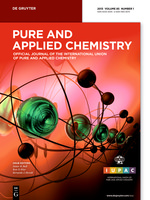 A new issue of Pure and Applied Chemistry is now available on De Gruyter Online.
A new issue of Pure and Applied Chemistry is now available on De Gruyter Online.
Please click on the following links to view the articles:
Pure and Applied Chemistry Volume 93, Issue 4
Frontmatter
Special Topic Issue
Preface
Francesca M. Kerton
Pure and Applied Chemistry Chemical Research Applied to World Needs (CHEMRAWN) issue 407
https://doi.org/10.1515/pac-2021-1007
CHEMRAWN, which stands for Chemical Research Applied to World Needs, is a standing committee of IUPAC. It was established in the mid-1970s, with the purpose of increasing IUPAC’s engagement with societal issues related to chemistry. The committee’s work targets the use of chemical research to meet unmet world needs through the application of chemistry and chemical technologies. Many of the issues that CHEMRAWN members have been involved with over the past decades are now encompassed by the UN Sustainable Development Goals. In 2021, the CHEMRAWN XXII conference “E-waste in Africa” will be held in Lagos, Nigeria using a hybrid model to allow global involvement during the ongoing Covid-19 pandemic. This milestone in our conference series comes 43 years after the first CHEMRAWN Conference, which was on “Future Sources of Organic Raw Materials”. The consideration of sugars, carbon dioxide and other materials as alternate feedstocks to fossilized resources (e.g. petroleum) is still important today, as exemplified by some of the articles in this special issue. CHEMRAWN conferences over the past four decades have covered an array of topics including agriculture, water, health and energy.
We continue to organize our established one-of-a-kind multidisciplinary conferences, but we are also working on outreach activities, workshops and symposia to highlight and address global needs that could benefit from applied chemistry research. Chemical sciences play an important role today in enhancing research capacity around the world so that everyone can work together towards solving both local and global needs in an equitable fashion (e.g. access to clean water and food, combatting climate change).
We are proud partners with the IUPAC Interdivisional Committee on Green Chemistry for Sustainable Development in administering the IUPAC-CHEMRAWN VII Prize for Green Chemistry, which is a legacy of the CHEMRAWN VII conference “Chemistry of the Atmosphere: Its Impact on Global Change”. This award recognizes a young scientist from a developing country whose research contributes to the field of green chemistry, while emphasizing atmospheric chemistry. We encourage any younger readers of this special issue to consider applying for this award in the future.
For this special issue, we have collected six papers that address matters related to the concerns of the
CHEMRAWN committee. We hope you enjoy reading them.
Katarzyna Szwaczko, Barbara Miroslaw, Oleg M. Demchuk, Grzegorz Wójciuk, Liliana Mazur and Kazimierz Michał Pietrusiewicz
Metathetic approach to new NORPHOS-related bisphosphanes: facile synthesis and application in asymmetric hydrogenation 409
Karolina Kula, Agnieszka Kącka-Zych, Agnieszka Łapczuk-Krygier and Radomir Jasiński
Analysis of the possibility and molecular mechanism of carbon dioxide consumption in the Diels-Alder processes 427
Igor Yu. Kaplin, Ekaterina S. Lokteva, Svetlana V. Bataeva, Konstantin I. Maslakov, Alexander V. Fionov, Alexey V. Shumyantsev, Oksana Ya. Isaikina, Alexey O. Kamaev and Elena V. Golubina
Effect of MnOx modification and template type on the catalytic performance of ceria-zirconia in CO and soot oxidation 447
Yi Liu and Francesca M. Kerton
Mechanistic studies on the formation of 5-hydroxymethylfurfural from the sugars fructose and glucose 463
Agnieszka Dąbrowska, Iwona Łopata and Magdalena Osial
The ghost nets phenomena from the chemical perspective 479
Magdalena Warczak, Marianna Gniadek, Kamil Hermanowski and Magdalena Osial
Well-defined polyindole–Au NPs nanobrush as a platform for electrochemical oxidation of ethanol 497
